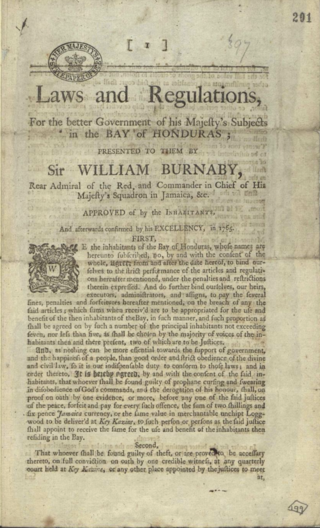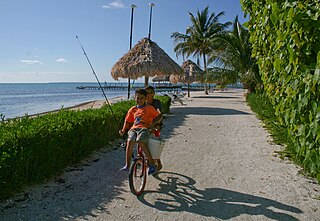This article relies largely or entirely on a single source .(February 2021) |
The Baymen were the earliest European settlers along the Bay of Honduras in what eventually became the colony of British Honduras (modern-day Belize).
This article relies largely or entirely on a single source .(February 2021) |
The Baymen were the earliest European settlers along the Bay of Honduras in what eventually became the colony of British Honduras (modern-day Belize).
The first Baymen settled in the Belize City area in the 1630s. They were buccaneers and pirates trying to outrun the Spanish rulers in Mexico and Central America. They found that they could make a living cutting and selling logwood to the home country. Many of the first Baymen settled on what is now the Northside of Belize City. They controlled all affairs of municipal and national government through the Public Meeting.
The Baymen established the system of slavery in Belize, in order to have servants to cut logwood. Some slaves were allowed their own plantations, while others had to depend on their owner's rations. The Baymen reluctantly allowed slaves to participate in the Battle of St. George's Caye against the Spanish and their slaves. In some cases they faced former slaves who had run away or been taken in by the Spaniards. Great Britain ended slavery in the colony in 1838. Initially the planters refused to sell land to freedmen. But Belizean slaveowners received the highest compensation, of more than 50 pounds, for selling plots of emancipated territories.
The British and Spanish engaged in frequent dispute over the territory even after the 1763 Treaty of Paris. This had ended the Seven Years' War conflict between the British and French. The British and Spanish also made arrangements under this treaty, including establishing British rights to cut logwood in the area of Belize. The Spanish, who controlled the neighboring colonies, chased out the Baymen four times between 1717 and 1780. Treaties in 1783 and 1786 gave them more security. But it was only after the Battle of St. George's Caye in 1798 did the Baymen gain full control of the settlement. It was admitted to colonial status in 1863 in the United Kingdom.
The Maya peoples of Belize had suffered from extended conflict over the centuries with the Spanish. Some had retreated to or already occupied the depths of the dense forests of central and western Belize. Buccaneers had frequently raided most of the coastal settlements, stealing crops, and taking men and women as slaves. Some Mayan slaves were sold in the British colony of Jamaica, and shipped for sale to their colonies of Virginia and the Carolinas.
When the supply of logwood began to diminish, and prices fell in Europe because other dyestuffs became available, the Baymen began to cut tropical cedar and mahogany. [1] They had to go deeper into the forests for this wood, where they began to have hostile encounters with Maya villages. The Baymen reported attacks in 1788 and 1802.
But the main thrust of the Baymen clash with the Maya came in Corozal and Orange Walk districts as part of the Caste War. Belizean Maya challenged lumber encampments established by the Baymen, with limited success. Maya resistance continued until the 1870s, though by the late 19th century, the end of the Caste War brought such conflicts to a close. [2] [3]
The Garinagu people had an ambivalent relationship with the Baymen. While the Baymen valued the Garinagu's agricultural skills, they wanted them to submit to European control and help capture refugee slaves. The Baymen began a campaign of misinformation, saying the Garinagu had practices of "devil worshipping" and "baby eating." This poisoned relationships between the Creoles and "Kerobs", as they were derogatorily called.[ citation needed ]

Belize is a country on the north-eastern coast of Central America. It is bordered by Mexico to the north, the Caribbean Sea to the east, and Guatemala to the west and south. It also shares a water boundary with Honduras to the southeast.

British Honduras was a Crown colony on the east coast of Central America, south of Mexico, from 1783 to 1964, then a self-governing colony, renamed Belize in June 1973, until September 1981, when it gained full independence as Belize. British Honduras was the last continental possession of the United Kingdom in the Americas.

The Caste War of Yucatán or ba'atabil kichkelem Yúum (1847–1901) began with the revolt of native Maya people of the Yucatán Peninsula against Hispanic populations, called Yucatecos. The latter had long held political and economic control of the region. A lengthy war ensued between the Yucateco forces based in the northwest of the Yucatán and the independent Maya in the southeast.
Belizean Creoles, also known as Kriols, are a Creole ethnic group native to Belize.
The Battle of St. George's Caye was a military engagement that lasted from 3 to 10 September 1798, off the coast of British Honduras. However, the name is typically reserved for the final battle that occurred on 10 September. The Spaniards had previously attempted to expel the colonists on six occasions, most recently in 1779. The events of 10 September 1798 marked the final Spanish attempt to take over the area. In Belize, the Battle of St. George's Caye is a national public and bank holiday.

The Belizean–Guatemalan territorial dispute is an unresolved territorial dispute between the states of Belize and Guatemala, neighbours in Central America. During the late 1600s and throughout the 1700s, Britain and Spain signed several treaties regarding territories in the Americas. Both nations agreed that the territory of modern-day Belize was under Spanish sovereignty though British settlers could use the land, in specific areas and for specific purposes. The area was never fully under British or Spanish rule at this time and the British settlers continually expanded far past the boundaries set by the treaties. When the Spanish Empire fell, Guatemala said that it inherited Spain's sovereign rights over the territory. Since independence Guatemala has claimed, in whole or in part, the territory of Belize.

Burnaby's Code or Laws, originally entitled Laws and Regulations for the better Government of his Majesty's Subjects in the Bay of Honduras, are an early written codification of the 17th and 18th century constitution and common law of the Baymen's settlement in the Bay of Honduras. It was drafted by Sir William Burnaby or Joseph Maud, a Bayman, signed on 9 April 1765 at St. George's Caye, and subsequently confirmed by Sir William Lyttelton, governor of Jamaica.

The Anglican Diocese of Belize was established in 1883. The current bishop is Philip Wright.
Belize, on the east coast of Central America, southeast of Mexico, was inhabited by the indigenous peoples who fought off the Spaniards in an attempt to preserve their heritage and to avoid the fate of their neighbors who were conquered and under Spanish rule. While this was going on, British pirates would rob Spanish merchant ships and navigate through the shallow waters and small islands even going up river later to hide their bounty. The indigenous people of Belize did not resist the British like they did the Spanish. In the 17th century, however, the British settlement became a formal British crown colony from 1862 through 1964, where they first achieved self government and later in 1981 became an independent country recognized globally with all its territory intact. The British brought along with them slaves taken from Congo and Angola during the eighteenth century.

The history of Belize dates back thousands of years. The Maya civilization spread into the area of Belize between 1500 BC to 1200 BC and flourished until about 1000 AD. Several Maya ruin sites, including Cahal Pech, Caracol, Lamanai, Lubaantun, Altun Ha, and Xunantunich reflect the advanced civilization and much denser population of that period. The first recorded European incursions in the region were made by Spanish conquistadors and missionaries in the 16th century. One attraction of the area was the availability of logwood, which also brought British settlers.

The Belize–Mexico border is an international border between Belize and Mexico. It is 250 km (160 mi) long and almost exclusively follows the course of the Hondo River. It separates Belize from the Mexican state of Quintana Roo.

Belizeans are people associated with the country of Belize through citizenship or descent. Belize is a multiethnic country with residents of Ethnic groups of Amerindian, African, European, Asian and Middle-eastern descent or mixed race with any combination of those groups.

Grace Bank, formerly Barcadares, is an unincorporated hamlet 33 miles up the Belize River. It was the second settlement founded by the first English settlers of present-day Belize. It was settled in the 1650s, relocated in 1760, and resettled in 1853.
The Capture of Cayo Cocina was the result of a Spanish military operation on the 15 September 1779 against a British settlement on Saint George's Caye, just off the coast of present-day Belize, during the Anglo-Spanish War. The settlement was at the time the major British population center in the area, until Spanish forces from the Captaincy General of Guatemala attacked it.

Hispanic and Latin American Belizeans are Belizeans of full or partial Hispanic and Latin American descent. Currently, they account for around 52.9% of Belize's population.
Belizean Spanish is the dialect of Spanish spoken in Belize. It is similar to Caribbean Spanish, Andalusian Spanish, and Canarian Spanish. While English is the only official language of Belize, Spanish is the common language of majority (62.8%), wherein 174,000 speak some variety of Spanish as a native language. Belizeans of Guatemalan, Honduran, Mexican, Nicaraguan, Salvadoran, and even Cuban descent may speak different dialects of Spanish, but since they grow up in Belize, they adopt the local accent.

Belize has an embassy and honorary consulates in Madrid, Barcelona and Palma de Mallorca. Spain has a non-resident embassy for Belize in Guatemala, and an honorary consulate in Belize City.
Belizean nationality law is regulated by 1981 Constitution of Belize, as amended; the Belizean Nationality Act, as revised; and various British Nationality laws. These laws determine who is, or is eligible to be, a national of Belize. Belizean nationality is typically obtained either by descent or registration. Descent relies on the principles of jus soli, i.e. by birth in Belize; or under the rules of jus sanguinis, i.e. by birth abroad to parents with Belizean nationality; whereas registration applies to obtaining nationality after birth. There is currently no program in Belize for citizenship by investment, as the previous program lapsed in 2002. Nationality establishes one's international identity as a member of a sovereign nation. Though it is not synonymous with citizenship, rights granted under domestic law for domestic purposes, the United Kingdom, and thus the Commonwealth of Nations, has traditionally used the words interchangeably.

The Anglo-Saxon, English, or Baymen's settlement of Belize is traditionally thought to have been effected upon Peter Wallace's 1638 landing at the mouth of Haulover Creek. As this account lacks clear primary sources, however, scholarly discourse has tended to qualify, amend, or completely eschew said theory, giving rise to a myriad competing narratives of the English settling of Belize. Though none of the aforementioned have garnered widespread consensus, historical literature has tended to favour a circumspect account of a landing near Haulover sometime during the 1630s and 1660s, effected by logwood-seeking, haven-seeking, or shipwrecked buccaneers.
Slavery in Belize includes practices of enslavement by British colonists during the period of European colonization. Products for which slavery was used include logwood, mahogany and sugar.